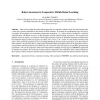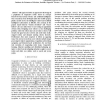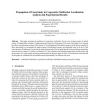CONSTRAINTS
2002
13 years 11 months ago
2002
It is a challenging task for a team of multiple fast-moving robots to cooperate with each other and to compete with another team in a dynamic, real-time environment. For a robot te...
AROBOTS
2000
13 years 11 months ago
2000
Most of the straight-forward learning approaches in cooperative robotics imply for each learning robot a state space growth exponential in the number of team members. To remedy the...
AROBOTS
2000
13 years 11 months ago
2000
In this article, we present the design of a team of heterogeneous, centimeter-scale robots that collaborate to map and explore unknown environments. The robots, called Millibots, a...
CORR
2004
Springer
13 years 11 months ago
2004
Springer
- This paper describes an approach to the design of a population of cooperative robots based on concepts borrowed from Systems Theory and Artificial Intelligence The research has b...
CORR
2004
Springer
13 years 11 months ago
2004
Springer
An optimization problem that naturally arises in the study of swarm robotics is the Freeze-Tag Problem (FTP) of how to awaken a set of "asleep" robots, by having an awak...
AROBOTS
2002
13 years 11 months ago
2002
If we are to build human-like robots that can interact naturally with people, our robots must know not only about the properties of objects but also the properties of animate agent...
AROBOTS
2002
13 years 11 months ago
2002
We present an approach to path planning for humanoid robots that computes dynamically-stable, collision-free trajectories from full-body posture goals. Given a geometric model of t...
AROBOTS
2002
13 years 11 months ago
2002
This paper addresses the problem of tracking multiple targets using a network of communicating robots and stationary sensors. We introduce a Region-based Approach which controls r...
AROBOTS
2004
13 years 11 months ago
2004
Robotics researchers have studied robots that can follow trails laid by other robots. We, on the other hand, study robots that leave trails in the terrain to cover closed terrain r...
AROBOTS
2004
2004
Propagation of Uncertainty in Cooperative Multirobot Localization: Analysis and Experimental Results
13 years 11 months ago
This paper examines the problem of cooperative localization for the case of large groups of mobile robots. A Kalman filter estimator is implemented and tested for this purpose. The...



